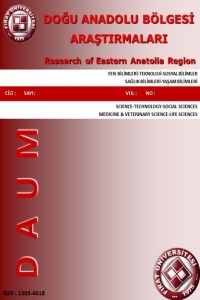SIÇAN OLFAKTOR EPİTELİNDE KOLŞİSİN İNDÜKLÜ APOPİTOZİSİN P-53 İLE VE YENİLENMESİNİN PCNA İLE GÖSTERİLMESİ
Kolşisin, Olfaktor Epitel, Apopitozis, Pproliferasyon
___
- 1. Borisy GG, Taylor EW. 1967. The mechanism of action of colchicine. Binding of colchicine 3H to cellular protein. J Cell Biol. 34, 525-534.
- 2. Burd GD. 1993. Morphological study of the effects of intranasal zinc sulfate irrigation on the mause olfactory epithelium and olfactory bulb. Microsc Res Tech. 24, 195-213.
- 3. Caggiano M, Kauer JS, Hunter DD. 1994. Globose bazal cells are neuronal progenitors in the olfactory epithelium: a lineage analysis using a replication ancompetent retrovirus. Neuron.13, 339-352.
- 4. Carr V McM,Farbman AI. 1992. Ablation of the olfactory bulb up-regulates the rate of neurogenesis and induces precocious cell death in olfactory epithelium. Exp Neurol. 115: 55-59.
- 5. Costanzo RM.1984. Comparation of neurogenesis and cell replacement in the hamster olfactory system with and without a target (olfactory bulb). Brain Res. 307,295-301.
- 6. Ginn SR, Peterson GM. 1991. Colchicine induced cholinergic denervation of the hippocampus elicits sympathetic ingrowth. Brain Res. 554, 257-263.
- 7. Ginn SR, Peterson GM. 1992. Fate of septohippocampal neurons following intracerebroventricular injections of colchicine. Brain Res. 29, 635-642.
- 8. Graziadei PPC, Monti- Graziadei GA. 1979. Neurogenesis and neuron regeneration in the olfactory system of mammals. I. Morphological aspects of differantion and structural organization of the olfactory sensory neurons. J Neurocytol. 8,1-18.
- 9. Heale VR, Petersen K, Vanderwolf CH. 1996. Effect of colchicine-induced cell loss in the dentate gyrus and Ammon’s horn on the olfactory control of feeding in rats. Brain Res 18: 712 (2), 213-20.
- 10. Heale VR, Vanderwolf CH, Leung LS. 1995. The neurotoxins colchicine and kainic acid block odor-induced fast waves and olfactory-evoked potentials in the dentate gyrus of the behaving rat. Brain Res 4: 690 (2) ,157-66.
- 11. Huard JMT, Schwob JE. 1995. Cell cycle of globose basal cells in rat olfactory epithelium. Dev Dyn. 203, 17-26.
- 12. Nadi NS,Head R, Grillo M, Hempstead J, Grannot-Reisfeld N, Margolis FL. 1981. Chemical deafferantion of the olfactory bulb: plasticity of the levels of tyrosine hydroxylase, dopamine and norepinephrine. Brain Res. 213, 365-377.
- 13. Nakagawa-Yagi Y. 1994. Induction of apoptotic cell death in differantion neuroblastoma SH-SY5Y cells. Biochem Biophys Res Commun. 199, 807-817.
- 14. Schwob JE, Mieleszko Szumowski KE, Stasky AA. 1992. Olfactory sensory neurons are trophically dependent on the olfactory bulb for their prolonged survival. J Neurosci. 12, 3896- 3919.
- 15. Schwob JE,Youngentob SL, Mezza RC. 1995. Reconstitution of the rat olfactory epithelium after methyl bromide-induced lesion. J Comp Neurol. 359, 15-37.
- 16. Suzuki Y, Takeda M. 1991 (a). Basal cells in the mause olfactory epithelium after axotomy: immunohistochemical and electron microscopic studies. Cell Tissue Res. 59, 171-178.
- 17. Suzuki Y, Takeda M, Farbman AI. 1996. Supporting cell as phagocytes in the olfactory epithelium after bulbectomy. J Comp Neurol. 376, 509-517.
- 18. Suzuki Y, Takeda M, Obara N. 1998. Colchicine-induced cell death and proliferation in the olfactory epithelium and vomeronasal organ of the mouse. Anat Embryol. 198, 43-51.
- 19. Vaux DL, Whitney D, Weissman IL. 1996. Activation of physiological cell death mechanism by a necrosis-causing agent. Microsc Res Tech. 34, 259-266.
- ISSN: 1303-4618
- Başlangıç: 2002
- Yayıncı: Fırat Üniversitesi
KARŞIT AKIŞLI REJENERATÖR ETKİNLİĞİNİN SONLU FARKLAR YÖNTEMİYLE ÇÖZÜMÜ
BAZI TOPRAK VE BİTKİ ÖRTÜSÜ ÖZELLİKLERİ ARASINDAKİ İLİŞKİLER
FİBER-MATRİKS ARAYÜZEYİNDE GERİLME ANALİZİ
GÜNEŞ ENERJİLİ VE NEM KONTROLLÜ KONDENZASYONLU BİR KERESTE KURUTMA FIRINI’NIN MODELLENMESİ
BİR ALMAN ÇOBAN KÖPEĞİNDE BAĞIRSAK OBSTRÜKSİYONU VE OPERATİF SAĞALTIMI
Ali Said DURMUŞ, Murat DABAK, Ömer KIZIL
SPORTİF AÇIDAN REKREASYON ETKİNLİKLERİNİN DEĞERLENDİRMESİ
Fikret RAMAZANOĞLU, Oğuzhan ALTUNGÜL, Arzu ÖZER
MUŞ BÖLGESİ FUTBOLCULARINI BU SPORA YÖNELTEN MOTİVASYONEL ETKENLERİN ARAŞTIRILMASI
Mehmet ÇEBİ, Murat ELİÖZ, Abdullah CANİKLİ, Murat KALDIRIMCI, Yonca Süreyya BİÇER, Cenk GÜRKAN
Semih YILMAZ, Ali DEMİR, Abdurrahman KEPOĞLU, Selçuk ZERDECİ
